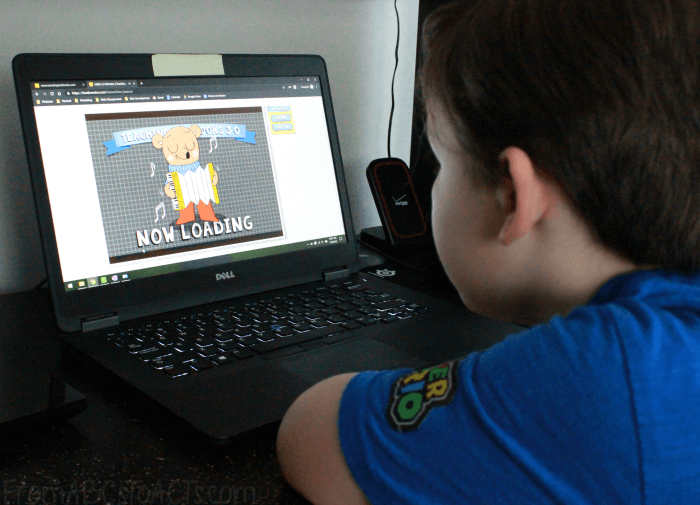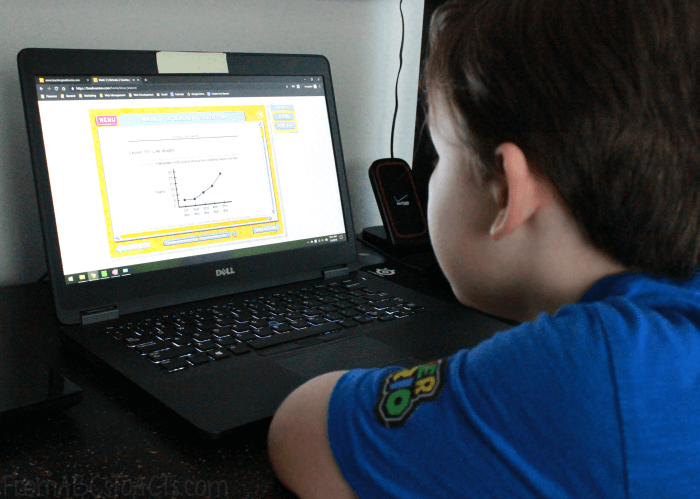This is a sponsored post. The sponsoring company compensated me for my time, however all opinions and text are my own. For more information, please see my full disclosure policy.
Math.
That one word is enough to strike fear and anxiety into the hearts of both parents and children everywhere.
It’s not that the subject itself is all that awful, it’s just that math is often misunderstood, not taught very well, or just made out to be the most boring thing in the world.
But to really get your kids excited about their education, to get them to really love learning, you’ll have to, at some point, get them really excited about math as well.
So, how do you make math fun for kids?

This is a sponsored post on behalf of Teaching Textbooks. I am being compensated for my time, however, all text and opinions are my own.
How to Make Math Fun for Kids
Making math fun for kids doesn’t have to be hard. In fact, it can be as easy as playing some games and breaking out the math manipulatives. The most important thing is to make sure that you’re trying to have fun with it as well.
If you feel like you hate math or that you dread helping your child with theirs, they’re going to pick up on that and share the same sentiments without ever really giving it a chance.
Now, obviously, you want the opposite.
Fortunately, a few of these tips for making math fun for kids should get you moving in the right direction.
Play Some Math Games
The sheer number of games out there that can help both you and your child brush up on your math skills would boggle your mind.
Games like Qwirkle, Battleship, UNO, or even old fashioned Dominoes can quickly inspire some mathematical thinking while making for a fun game night for the whole family.
Add Math to Your Daily Routine
Math is one of those skills that is more easily learned when it is not only practiced often but also applied to real-life situations.
Creating these connections between math concepts and real life not only allow your child to understand easier but also make it a whole lot more fun for them as they’re not struggling as hard to grasp new concepts.
For example, if you’re just starting to introduce your child to fractions, try breaking out the measuring cups and baking a batch of cookies. If they’ve recently started learning to measure the length and width of objects, find a small wooden project that you could build together.
Tying what they’re learning to real life situations not only allows them to see how these concepts can relate to their everyday lives but also makes the learning process a lot more fun and hands-on in the process.
Use Math Manipulatives
For most children, working out math problems in their heads is not an easy task, especially if they have just been recently introduced to a new concept.
Taking the time to dig out the math manipulatives gives them a more tangible way to see the math problem.
Whether you’re working on basic early math skills like counting with your preschooler or more complex concepts like division with your grade-schooler, children of all ages can benefit from a more hands-on approach to solving math equations.
Let Your Kids Make Their Own Math Problems
Your child probably has no interest in how many watermelons Mr. Miller has after growing some in his backyard and having his neighbor give him five more. They just don’t care how long it will take train A to travel to point B. You probably don’t either.
But, they are passionate about something.
Figure out what that something is and use it to your (and their) advantage.
If your child is really into building with LEGO bricks, have them create their own math problem to figure out how many bricks they’ll need to build a specific creation. Use their Minecraft knowledge to determine the area of a square.
Let them take the lead a little bit and use what they love to make math fun for them.
Make Good Use of Your Screen Time
Not all screen time is created equally and the math curriculum site Teaching Textbooks provides us with the perfect example of that.
Most math sites are either not very good at explaining concepts so that kids can actually understand them or they’re just flat out boring and repetitive.
Teaching Textbooks, on the other hand, isn’t trying to be like most of the other math sites out there.

This was obvious to use when we tried out their program for the first time, but in the event that you’d like to hear it straight from the source, here’s what Shawn Sabouri, one of Teaching Textbooks’ creators, has to say.
“Managing the student’s attitudes toward math is more than half the battle. So many kids have been defeated by math. They’ve been psyched out.
How do you do a restart in a situation like that?
Well, you need a curriculum that looks kid-friendly and talks to the student in a very kid-friendly way.
No curriculum surpasses TT on this front.
Second, even kids that are good at math or don’t absolutely hate math, still need a curriculum that is motivating…a curriculum that they don’t mind doing…a curriculum that you don’t have to nag them to do.
TT achieves this.
With TT, doing math is no longer like taking medicine. Math becomes a rewarding activity because it’s challenging yet structured in a way that enables kids to succeed.”

And with Teaching Textbooks 3.0, it’s all online!
No more random books and discs that have the chance of getting either lost or scratched.
Just pull up the website, sign in, and start learning.
They’ll even give you a free trial to get you started.
This free trial gives you access to as many courses as you’d like, from Math 3 to Pre-Calculus, and you’ll have access to everything, all features and equations, through Lesson 15, giving you and your child the opportunity to actually test it out on their level before deciding whether or not it’s the right program for you.
There’s even a large family discount plan that helps keep the cost down should you choose to use it with all of your kids.

Teaching Textbooks challenges your child while fully explaining the mathematical concepts that it is teaching.
In other words, it teaches your child HOW to solve the equation in a kid-friendly way rather than simply repeating the same information over and over again and then showing them the correct answer and how the problem should be solved.
It’s the ultimate way to make math fun for your kids and less of a dreaded, headache-inducing experience for yourself.
